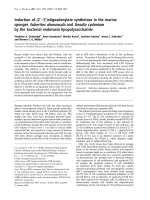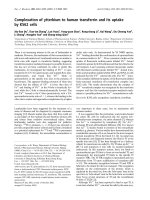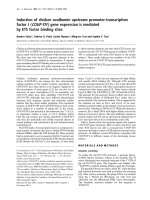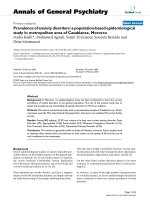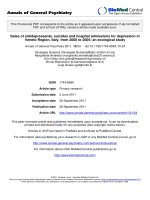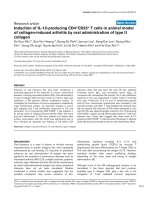Báo cáo y học: "Induction of HLA-B27 heavy chain homodimer formation after activation in dendritic cells" ppsx
Bạn đang xem bản rút gọn của tài liệu. Xem và tải ngay bản đầy đủ của tài liệu tại đây (465.33 KB, 7 trang )
Open Access
Available online />Page 1 of 7
(page number not for citation purposes)
Vol 10 No 4
Research article
Induction of HLA-B27 heavy chain homodimer formation after
activation in dendritic cells
Susana G Santos
1
, Sarah Lynch
1
, Elaine C Campbell
1
, Antony N Antoniou
2
and Simon J Powis
1
1
Bute Medical School, Westburn Lane, University of St Andrews, Fife, KY16 9TS, UK
2
Department of Immunology and Molecular Pathology, Windeyer Institute of Medical Science, 46 Cleveland St, University College London, London,
W1T 4JF, UK
Corresponding author: Simon J Powis,
Received: 17 Apr 2008 Revisions requested: 10 Jun 2008 Revisions received: 24 Jul 2008 Accepted: 29 Aug 2008 Published: 29 Aug 2008
Arthritis Research & Therapy 2008, 10:R100 (doi:10.1186/ar2492)
This article is online at: />© 2008 Santos et al.; licensee BioMed Central Ltd.
This is an open access article distributed under the terms of the Creative Commons Attribution License ( />),
which permits unrestricted use, distribution, and reproduction in any medium, provided the original work is properly cited.
Abstract
Introduction Ankylosing spondylitis (AS) is a severe, chronic
inflammatory arthritis, with a strong association to the human
major histocompatibilty complex (MHC) class I allele human
leucocyte antigen (HLA) B27. Disulfide-linked HLA-B27 heavy-
chain homodimers have been implicated as novel structures
involved in the aetiology of AS. We have studied the formation
of HLA-B27 heavy-chain homodimers in human dendritic cells,
which are key antigen-presenting cells and regulators of
mammalian immune responses.
Method Both an in vitro dendritic-like cell line and monocyte-
derived dendritic cells from peripheral blood were studied. The
KG-1 dendritic-like cell line was transfected with HLA-B27
cDNA constructs, and the cellular distribution, intracellular
assembly and ability of HLA-B27 to form heavy-chain
homodimers was compared with human monocyte-derived
dendritic cells after stimulation with bacterial lipopolysaccharide
(LPS).
Results Immature KG-1 cells expressing HLA-B27 display an
intracellular source of MHC class I heavy-chain homodimers
partially overlapping with the Golgi bodies, but not the
endoplasmic reticulum, which is lost at cell maturation with
phorbyl-12-myristate-13-acetate (PMA) and ionomycin.
Significantly, the formation of HLA-B27 homodimers in
transfected KG-1 cells is induced by maturation, with a transient
induction also seen in LPS-stimulated human monocyte-derived
dendritic cells expressing HLA-B27. The weak association of
wildtype HLA-B*2705 with the transporter associated with
antigen processing could also be enhanced by mutation of
residues at position 114 and 116 in the peptide-binding groove
to those present in the HLA-B*2706 allele.
Conclusion We have demonstrated that HLA-B27 heavy-chain
homodimer formation can be induced by dendritic cell
activation, implying that these novel structures may not be
displayed to the immune system at all times. Our data suggests
that the behaviour of HLA-B27 on dendritic cells may be
important in the study of inflammatory arthritis.
Introduction
Ankylosing spondylitis (AS) and related spondyloarthropathies
(SpA) are strongly associated with the major histocompatibilty
complex (MHC) class I allele human leucocyte antigen (HLA)
B27. Several theories have developed to explain the link
between HLA-B27 and SpA, the classical example being
based on its antigen presentation function and the possibility
of molecular mimicry [1]. However, the absence of a bona fide
arthritogenic peptide and transgenic rat studies demonstrat-
ing a significant role in disease onset for CD4
+
, rather than
CD8
+
, T cells while not ruling out a role for peptide presenta-
tion, suggests that other mechanisms may also be involved
[2,3].
More recently, theories have emerged based on several non-
antigen presentation properties of HLA-B27 [4]. One area of
particular focus has been the demonstration of misfolding of
HLA-B27 in the endoplasmic reticulum (ER), which leads to
induction of the unfolded protein stress response [5]. Also,
natural killer (NK) receptor recognition of non-canonical con-
AS = ankylosing spondylitis; ER = endoplasmic reticulum; FBS = fetal bovine serum; HLA = human leucocyte antigen; IFN = interferon; IL = inter-
leukin; LPS = lipopolysaccharide; MHC = major histocompatibility complex; NEM = n-ethyl maleimide; NK = natural killer cell; PBS = phosphate buff-
ered saline; SDS-PAGE = sodium dodecyl sulphate polyacrylamide gel electrophoresis; SpA = spondyloarthropathies; TAP = transporter associated
with antigen processing; TBS = Tris buffer.
Arthritis Research & Therapy Vol 10 No 4 Santos et al.
Page 2 of 7
(page number not for citation purposes)
formations of HLA-B27, in the form of heavy-chain
homodimers has been reported as a potential contributor to
AS development [6]. B27 homodimers were first discovered
during in vitro MHC class I folding studies [7], and subse-
quently reported in cell lines, transgenic animals and patient
samples [8-10]. These cell surface HLA-B27 homodimers can
be recognised by NK receptors such as KIR3DL2 that do not
recognise the monomeric form [11]. Enhanced numbers of NK
cells and CD4+ T cells expressing these receptors have been
reported in AS patients [12]. However, factors influencing the
formation of HLA-B27 heavy-chain dimers remain poorly
characterised.
Dendritic cells are essential to the initiation of most antigen-
specific immune responses, as well as being involved in innate
immune responses [13]. As such they are also pivotal to the
understanding of disease and autoimmune phenotypes [14].
Recent observations into potentially abnormal interactions of
HLA-B27 expressing dendritic cells with non-antigen specific
T cells have brought dendritic cells into the forefront of AS
research [15].
Here we show, in a human dendritic cell-like cell line and in
human monocyte-derived dendritic cells, that the formation of
HLA-B27 homodimers follows maturation and activatory stim-
uli. Our data indicates that heavy-chain dimer formation can be
a relatively transitory feature induced by activation, which may
impact on dendritic cell behaviour during a critical period of a
developing immune response.
Materials and methods
Cells
The human KG-1 cell line (expressing HLA-A30, -A31, -B35
and -Cw4; ECACC, HPA Cultures, Wiltshire, UK) was main-
tained in Iscove's Modified Dulbecco's Medium (IMDM)
(Gibco, Paisley, UK), plus 20% fetal bovine serum ([FBS]
Gibco, Paisley, UK) and kanamycin (Gibco, Paisley, UK). Sta-
ble transfectants of KG-1 made with cDNA for HLA-B*2705
with and without the C-terminal sv5 epitope tag [16] were
generated using the Amaxa Nucleofector (Amaxa AG.,
Cologne, Germany). Site-directed mutagenesis to generate
mutant B27.H114D.D116Ysv5 (histidine to aspartic acid at
position 114, and aspartic acid to tyrosine at position 116)
was performed using Stratagene Quickchange (Stratagene,
La Jolla, USA) methodology. Transfectants were selected and
maintained in 1 mg/ml G418 (Geneticin, Invitrogen, Paisley,
UK). KG-1 cells were differentiated/matured with 10 ng/ml
phorbyl-12-myristate-13-acetate (PMA) (Sigma, Poole, UK)
and 100 ng/ml ionomycin (Sigma, Poole, UK).
In agreement with the local medical school ethics committee,
informed written consent was obtained from donors before
blood collection. Samples were obtained from two HLA-B27-
expressing individuals and two non-HLA-B27-expressing indi-
viduals, as determined by flow cytometry with fluorescein iso-
thiocyanate (FITC) labelled-anti-HLA-B27 (VH Bio,
Gateshead, UK). For primary monocyte-derived dendritic cells,
peripheral blood mononuclear cells were obtained after cen-
trifugation over Histopaque (Sigma, Poole, UK). Monocytes
were allowed to adhere for two hours in RPMI-1640 medium
supplemented with 10% heat inactivated FBS and kanamycin
(Gibco, Paisley, UK). Non-adherent cells were then removed
and fresh medium supplemented with 50 ng/ml granulocyte
macrophage colony-stimulating factor (GM-CSF) and 50 ng/
ml interleukin (IL)-4 was added to the culture. Dendritic cells
were allowed to differentiate for four days, before treatment
with 50 ng/ml lipopolysaccharide (LPS, Sigma, Poole, UK) for
the indicated time periods.
Reagents and antibodies
The following antibodies were used in this study: monoclonal
anti-v5 tag (pK); W6/32 recognises folded HLA-A, B and C
molecules; ME1 recognises folded HLA-B molecules; HC-10
recognises partially folded HLA-B and -C molecules; 148.3
recognises human transporter associated with antigen
processing (TAP)1 [17]; anti-CD11c (Serotec, Kidlington,
UK). Bodipy-ceramide (Molecular Probes, The Netherlands),
goat anti-mouse HRP-conjugated secondary antibody (Perbio,
Cramlington, UK) and LPS from Salmonella enteritidis (Sigma,
Poole, UK) were also used.
Flow cytometry and immunofluorescence
Cells were resuspended in PFN (phosphate buffered saline
[PBS], 2% FBS, 0.1% sodium azide), stained with the indi-
cated antibodies and FITC-labelled second stage. Mouse
immunoglobulins were used as negative controls to define
background staining. Samples were analysed on a FACScan
(BD Biosciences, Oxford, UK) using BD Biosciences Cel-
lQuest software. For immunofluorescence microscopy cells
were fixed in 2% formaldehyde in PBS, blocked with 1% BSA
in PFN containing 0.2% saponin, stained with antibodies in
PFN with 0.2% saponin, and stained with FITC-labelled sec-
ond stage. The Golgi marker Bodipy TR C5-ceramide (Molec-
ular Probes, Leiden, The Netherlands) was used according to
the manufacturer's instructions. Stained cells were mounted
with Dapi (4',6-diamidino-2-phenylindole) containing Vectash-
ield (Vector Laboratories, Peterborough, UK). Deconvolution
microscopy was performed with a DeltaVision Restoration
Imaging System (Applied Precision, Issaquah, USA). A z-
series of 15 to 45 images at 0.35 μm intervals was captured
and processed using constrained interactive deconvolution via
SoftWoRx 3.0 software (Applied Precision, Washington,
USA). Further image analysis including volume sections were
generated using Image J open source software.
Western blotting, biotinylation and
immunoprecipitations
Cell lysates were prepared by pre-treating cells with 10 mM N-
ethyl maleimide (NEM) in PBS on ice for 10 minutess, and
then lysed in 1% NP40 lysis buffer with 10 mM NEM and 1
Available online />Page 3 of 7
(page number not for citation purposes)
mM phenylmethanesulphonylfluoride (PMSF). Lysates were
centrifuged at 14,000 rpm for 10 minutes. Protein was quan-
tified using Bradford reagents (Sigma, Poole, UK).
For biotinylation, cells were pre-treated with 10 mM NEM on
ice for 10 minutes before being labelled with 0.1 mg/ml Sulfo-
NHS-biotin (Sigma Poole, UK) for 10 minutes on ice. Free
biotin was quenched using Tris buffer (TBS) with 5% FBS,
samples were washed twice in TBS, followed by lysis as
above. Pre-cleared lysates were incubated with streptavidin-
agarose (Sigma, Poole, UK) beads for 25 minutes. Beads
were washed three times with lysis buffer, and resuspended in
20 μl non-reducing sample buffer.
Samples were run on 8% sodium dodecyl sulphate polyacry-
lamide gel electrophoresis (SDS-PAGE), transferred to nitro-
cellulose membrane and probed with the indicated antibodies
or streptavidin-HRP (Sigma, Poole, UK) and signals monitored
by chemiluminescence (Perbio, Cramlington, UK). Two-dimen-
sional gel analysis was performed as previously described
[18], followed by immunoblotting as above. Pulse-chase anal-
ysis was performed by labelling cells with 3.7 MBq Trans-label
(MP Biomedicals, Solon, USA), followed by lysis and immuno-
precipitation with relevant antibodies and Protein G beads
(Sigma, Poole, UK). Immune complexes were digested with
2.5 mU endoglycosidase H (Roche, West Sussex, UK) for one
hour at 37°C prior to SDS-PAGE.
Results
Distribution of HLA-B27 transfected KG-1 cells
In agreement with a previous report [19], with stimulation with
PMA and ionomycin for 24 hours and 72 hours, KG-1 cells up-
regulated cell surface CD11c, MHC class I (Figures 1a, b),
and CD83 (not shown). KG-1, which do not express endog-
enous HLA-B27, were transfected with non-tagged and
epitope-tagged versions of HLA-B*2705 cDNA. Cells
expressing epitope-tagged HLA-B27 (KG-1.B27sv5) up-reg-
ulated cell surface expression (Figures 1c, d), as did transfect-
ants expressing non-epitope tagged HLA-B27 (not shown).
Note that in untransfected KG-1 cells the anti-HLA-B mAb
ME1 weakly recognises the endogenous HLA-B35 allele (Fig-
ure 1c). The increase detected in HLA-B27 surface expres-
sion (Figure 1d) therefore occurred despite the cDNA being
under a non-endogenous (CMV) promoter. This may reflect
the increase in expression of components of the MHC class I
assembly pathway, such as ERp57 and tapasin, which we
have previously shown to increase with KG-1 maturation [20].
To determine the assembly kinetics of endogenous HLA class
I alleles in KG-1 cells in comparison to the expressed HLA-
B27 cDNA, we performed pulse-chase analysis. In KG-1.B27
cells, HLA-B27 molecules acquire endoglycosidase H resist-
ance (generally indicating exit of folded molecules from the
ER) with similar kinetics to the general MHC class I pool rec-
ognised by W6/32 in KG-1 cells (Figure 1e). ME1 immunopre-
cipitation of untransfected KG-1 cells did not reveal
detectable signal (not shown), in accordance with the rela-
tively weak flow cytometric staining in Figure 1c. Taken
together, our data suggests that the assembly of HLA-B*2705
in KG-1 cells appears similar to recent data studying the
Figure 1
Expression of HLA-B27 in KG-1 cellsExpression of HLA-B27 in KG-1 cells. Unstimulated KG-1 cells (solid
line) and KG-1 cells stimulated with PMA and ionomycin for 24 hours
(dashed line) or 72 hours (dotted line), were surface stained for (a) DC
markers CD11c and (b) W6/32 for MHC class I. (c) KG-1 and (d) KG-
1.B27sv5 cells, unstimulated (solid line) or stimulated with PMA and
ionomycin for 24 hours (dashed line), were surface stained with ME1,
recognising HLA-B alleles. The grey curves indicate second stage anti-
mouse FITC alone. (e) KG-1 and KG-1.B27 cells were metabolically
labelled with
35
S-Trans label, and cell lysates immunoprecipitated at
the indicated time points with W6/32 or ME1 antibodies, and digested
with endoH. (f) KG-1.B27 cells were differentiated with PMA and iono-
mycin for 24, 48 or 72 hours, and stained with ME1 (green) and the
Golgi dye Bodipy Ceramide (red). The white bar represents 5 μm. A
panel below the 24 hour image displays a red and green merged vol-
ume section, from the region indicated by the white line.
Arthritis Research & Therapy Vol 10 No 4 Santos et al.
Page 4 of 7
(page number not for citation purposes)
assembly of multiple HLA-B27 alleles, wherein various
subtypes of HLA-B27 acquired 50% endoglycosidase H
resistance within a range of 14 minutes (HLA-B*2706) to 52
minutes (HLA-B*2705) [21].
Some subpopulations of dendritic cells have the capacity to
store MHC class I molecules in an intracellular compartment
[22]. Similarly, immature KG-1 cells have previously been
shown to retain some MHC class I molecules in the Golgi [19],
a result we confirm also occurs with HLA-B27 (Figure 1f),
where cells stained with ME1 (green) and the Golgi specific
stain Bodipy-ceramide (red) show significant co-localisation.
The same results were observed with specific B27-FITC anti-
body reagents on KG-1.B27sv5 cells (not shown). No signifi-
cant overlap of HLA-B27 was observed with the ER-resident
chaperone calreticulin (not shown). Redistribution of the HLA-
B27 signal to the cell surface occurs, as expected, on matura-
tion (Figure 1f), with strong staining of dendritic cell-like struc-
tures. Thus, HLA-B27 molecules expressed in KG-1 dendritic
cell-like cells overall display behaviour similar to other MHC
class I molecules previously reported in this cell line [19], con-
firming it as a suitable model for the study of HLA-B27 in den-
dritic cell-like cells.
Association of HLA-B27 molecules with TAP in KG-1
cells
The MHC class I specific accessory molecule tapasin forms
part of the MHC class I peptide loading complex and assists
in optimising the pool of peptides bound by MHC class I mol-
ecules [23]. However, HLA-B27 can be expressed efficiently
in the absence of tapasin [24], even though it is loaded with a
suboptimal peptide cargo [23], suggesting a partial non-reli-
ance on TAP-association for peptide-loading. HLA-B27, when
expressed in tapasin-deficient cells, forms increased amounts
of HLA-B27 homodimers [9]. To assess the ability of HLA-B27
to interact with tapasin in our KG-1 dendritic cell model sys-
tem, we determined the ability of HLA-B27 to co-immunopre-
cipitate with TAP in digitonin lysates of our transfected KG-
1.B27 cells. In addition we compared it with a mutant of HLA-
B27 in which residues at positions 114 and 116 were mutated
to mimic the less disease-associated allele HLA-B*2706
(mutant termed H114D.D116Y). Residue 114 has been impli-
cated in determining tapasin, and therefore TAP association
[24]. As shown in Figure 2, HLA-B27 was detected in associ-
ation with TAP, but in significantly reduced amounts compared
with mutant KG-1.B27.H114D.D116Y. Thus in KG-1 den-
dritic cell-like cells HLA-B*2705 interacts relatively weakly
with TAP.
Induction of HLA-B27 heavy chain-homodimers after
dendritic cell stimulation
We then determined the ability of the HLA-B27-expressing
KG-1 cells to form the heavy-chain homodimer structures
implicated in NK-receptor recognition events [6]. Cells were
treated with PMA/ionomycin and whole-cell lysates tested at
0, 24 and 72 hours for dimer formation by immunoblotting with
the HLA-B reactive monoclonal antibody (mAb) HC10 and
epitope tag-specific mAb Pk. MHC class I signal increased at
24 and 48 hours after stimulation in both cell lines, especially
in the transfected cells, mirroring our flow cytometry data
shown in Figure 1d.
Heavy-chain dimer structures were detected in KG-1.B27
cells after 24 hours of stimulation, at which point multiple
bands in the 80 kDa region were visible (Figure 3a), and at 72
hours in KG-1.B27.H114D.D116Y cells, in which the higher
of the bands detected in KG-1.B27 cells was only weakly vis-
ible. The appearance of the HLA-B27 dimer structures later in
KG-1.B27.H114D.D116Y cells may reflect its stronger asso-
ciation with tapasin/TAP (Figure 2).
To determine whether any of these structures were also
expressed at the cell surface, we performed cell surface-spe-
cific biotinylation, followed by streptavidin pulldown and immu-
noblotting for MHC class I molecules [11]. Figure 3b shows
that the lower of the 80 kDa-region bands was most highly rep-
resented at the cell surface in KG1-B27 cells. To confirm this
80 kDa species as a B27 heavy-chain homodimer, we
performed immunoblotting of cell lysates separated by two-
dimensional electrophoresis. A spot resolved at 80 kDa
directly above the HLA-B27 monomer in transfected KG-1
cells (Figure 3c), which was the result expected for two asso-
ciated heavy chains possessing an identical isoelectric point
Figure 2
Association of HLA-B27 with TAP in KG-1 cellsAssociation of HLA-B27 with TAP in KG-1 cells. KG-1.B27sv5 and
KG-1.B27.H114D.D116Ysv5 cells were stimulated for 24 hours, lysed
in digitonin-containing buffer and immunoprecipitated with anti-TAP1
antibodies conjugated to Protein G beads. Samples and cell lysate
controls were resolved on sodium dodecyl sulphate polyacrylamide gel
electrophoresis (SDS-PAGE) and immunoblotted with the indicated
antibodies. Molecular mass markers are shown in kDa.
Available online />Page 5 of 7
(page number not for citation purposes)
of the HLA-B27 monomer. Overlaying gels confirmed this spot
as having similar migration characteristics as the lower of the
dimer-region bands seen in Figures 3a and 3b. We were una-
ble to detect any other significant spots that would allow us to
determine the nature of the other bands present in HLA.B27
transfected KG-1 lysates.
The above observations suggested that HLA-B27 heavy-chain
homodimers were a transient structure, reliant on the activa-
tion status and/or maturation of KG-1 cells for their formation.
Since most studies of HLA-B27 have focused on activated
cells or cells lines, we wished to determine if our observations
might also extend to HLA-B27 expressed endogenously in pri-
mary human dendritic cells. We therefore differentiated
peripheral blood monocyte-derived dendritic cells from one
individual expressing HLA-B27, and one control non-B27-
expressing individual. The dendritic cells were stimulated via
TLR4, using LPS and whole cell lysates prepared at times up
to 72 hours after stimulation. Similar to the results for KG-1
cells, the primary HLA-B27 expressing dendritic cells dis-
played the induction of dimer formation on stimulation. We
repeated these observations in two further dendritic cell sam-
ples stimulated with LPS for 48 hours. Of significant interest,
in the extended maturation cultures, heavy-chain dimer levels
peaked at 48 hours, declining thereafter (Figure 3d). Our
results show, for the first time, that B27 dimers can be
detected as a transient population in dendritic cells and are
dependent on their activation status.
Discussion
Most immune responses, both innate and adaptive, involve the
activation of multiple immune cell types, as a result of which
Figure 3
Induction of HLA-B27 heavy-chain dimers in KG-1 cells and human dendritic cellsInduction of HLA-B27 heavy-chain dimers in KG-1 cells and human dendritic cells. KG-1, KG-1.B27sv5 and KG-1.B27.H114D.D116Ysv5 cells
were stimulated with PMA and ionomycin for the indicated times (a) before preparation of cell lysates or surface biotinylation and (b) pulldown with
streptavidin-agarose beads. Immunoblots were probed with HC10 or anti-tag pK. (c) In 24-hour stimulated KG-1 and KG-1.B27sv5, cell lysates
were resolved under non-reducing conditions by two-dimensional gel electrophoresis, followed by immunoblotting with HC10 or pK. MHC class I
dimers and monomers are indicated. (d) In human monocyte-derived dendritic cells were generated from peripheral blood monocytes of two HLA-
B27-positive individuals and two negative controls, before being stimulated for 0, 24, 48 or 72 hours with lipopolysaccharides. Cells lysates were
resolved under non-reducing conditions and immunoblotted for MHC-class I heavy chain (HC-10). Class I dimers and monomers are indicated.
Molecular weight markers are shown in kDa.
Arthritis Research & Therapy Vol 10 No 4 Santos et al.
Page 6 of 7
(page number not for citation purposes)
many up-regulate the expression of components of the antigen
presentation pathway, including MHC class I molecules. We
therefore set out to determine whether dendritic cells
expressed HLA-B27 dimers, and to what extent cell activation
could induce HLA-B27 dimers in dendritic cells, which are
crucial cells for most immune responses, and have recently
been implicated in AS [15]. In this study we have demon-
strated the formation of HLA-B27 heavy-chain dimers in a
transfected dendritic cell-like cell line, and in HLA-B27-posi-
tive monocyte-derived human dendritic cells.
Significantly, dimers were essentially undetectable in unstimu-
lated cells, but usually appeared within 24 hours of activation.
Similarly, in macrophages from HLA-B27-expressing disease-
prone transgenic rats, HLA-B27 dimer-like structures are
readily detected after stimulation with interferon (IFN)-γ [5].
Thus, it is possible that these structures may only appear dur-
ing an active immune response. However, since we detected
dimers concomitantly with an increase in overall levels of HLA-
B27 heavy-chain dimers, it may be that dimers are normally
present at levels below our current detection level, a limitation
that we cannot at this stage formally exclude. Nonetheless, it
is possible that the immune system, since it relies on many
receptor-based interactions which involve the clustering of lig-
ands including MHC class I molecules [25], may likewise not
be able to see very low levels of dimer structures, and may
therefore itself rely on cell activation to detect them. This
observation could have an impact on the study of HLA-B27-
associated arthritis. For example, HLA-B27-associated reac-
tive arthritis usually develops after the significant immunologi-
cal challenge of a bacterial gut infection. Similarly, the disease-
prone HLA-B27 transgenic rat model is essentially disease
free when kept in specific pathogen-free conditions, and only
succumbs to disease when removed from these conditions
[26]. Both of these could be interpreted as sequelae to the
induction of large numbers of HLA-B27 heavy-chain dimers on
antigen-presenting cells, although it does not explain why
other significant immune challenges, such as viral infections,
are not seen to similarly trigger inflammatory arthritis.
In the case of the human monocyte-derived dendritic cells, we
also observed a decrease in dimer formation between 48 and
72 hours after activation. Recent in situ studies in the rat show
that dendritic cells from the intestine migrate to mesenteric
lymph nodes within 24 to 48 hours [27]. This could result in
the temporal exposure of HLA-B27 dimer structures within the
lymph node, where many of the crucial interactions that deter-
mine immune responses occur.
The fact that increased expression of MHC class I molecules
may predispose to heavy-chain dimer formation may be rele-
vant in other alleles as well as HLA-B27. We detected very low
quantities of dimer-sized bands in the HLA-B27-negative den-
dritic cell cultures (Figure 3d), and are currently investigating
the nature of these bands, which may represent a novel MHC
class I structure formed in non-HLA-B27-expressing cells (SL
and SJP, unpublished observations). We have previously
observed transient heavy-chain dimer-like structures in acti-
vated peripheral blood lymphocytes [28]. Furthermore, in stud-
ies of the tapasin-deficient .220 cell line, when restored with
tapasin and high levels of HLA-B8 we also detect the pres-
ence of dimer-like structures (SL and SJP, unpublished obser-
vations). How such dimers form in the absence of the unpaired
cysteine at position 67 in the peptide-binding groove, which
has been shown to be involved in HLA-B27 dimer formation
[7], remains to be determined, although contributions from
non-covalent interactions in high molecular weight HLA-B27
structures have been reported [29].
Although we have not included a significant number of human
samples in this present study, nor samples from patients with
actively defined AS, our data does suggest it would be of inter-
est to determine the burden of dimer structures that may exist
in non-activated and activated cells of different lineages, in
both the rat transgenic model and in human cells from HLA-
B27 healthy controls and patients with AS.
Conclusion
In summary, our data indicate that detectable HLA-B27 heavy-
chain dimer formation may be induced in important cell types
such as dendritic cells only on receiving an activatory stimulus.
A comprehensive study of heavy-chain dimer formation in
HLA-B27-positive individuals, both with and without AS, and
its correlation with dendritic cells and other immune cell acti-
vation, is currently lacking, but would probably provide further
insights into the potential availability of heavy-chain dimers as
targets for interaction with T and NK cell receptors.
Competing interests
The authors declare that they have no competing interests.
Authors' contributions
SS generated the transfectants and performed experimental
work in the study, designed experiments and drafted the man-
uscript. SL and EC carried out immunoblotting work in the
study and drafted the manuscript. AN performed site-directed
mutagenesis and was involved in the drafting of the manu-
script. SP designed experiments and wrote the manuscript.
Acknowledgements
The monoclonal anti-v5 tag (pK) antibody used in this study was a gift
from Rick Randall. The 148.3 antibody recognising TAP1 were used
with permission from Robert Tampe.
SGS was funded by the Portuguese Foundation for Science and Tech-
nology, grant number SFRH/BPD/20964/2004. SL is supported by the
University of St Andrews Maitland Ramsay studentship. ANA is funded
by the UK Arthritis Research Campaign, grant number 15293.
References
1. Ramos M, Lopez de Castro JA: HLA-B27 and the pathogenesis
of spondyloarthritis. Tissue Antigens 2002, 60:191-205.
Available online />Page 7 of 7
(page number not for citation purposes)
2. May E, Dorris ML, Satumtira N, Iqbal I, Rehman MI, Lightfoot E,
Taurog JD: CD8 alpha beta T cells are not essential to the
pathogenesis of arthritis or colitis in HLA-B27 transgenic rats.
J Immunol 2003, 170:1099-1105.
3. Smith JA, Marker-Hermann E, Colbert RA: Pathogenesis of anky-
losing spondylitis: current concepts. Best Pract Res Clin
Rheumatol. 2006, 20:571-591.
4. Penttinen MA, Ekman P, Granfors K: Non-antigen presenting
effects of HLA-B27. Curr Mol Med 2004, 4:41-49.
5. Turner MJ, Delay ML, Bai S, Klenk E, Colbert RA: HLA-B27 up-
regulation causes accumulation of misfolded heavy chains
and correlates with the magnitude of the unfolded protein
response in transgenic rats: implications for the pathogenesis
of spondylarthritis-like disease. Arthritis Rheum 2007,
56:215-223.
6. Kollnberger S, Bird L, Sun MY, Retiere C, Braud VM, McMichael
A, Bowness P: Cell-surface expression and immune receptor
recognition of HLA-B27 homodimers. Arthritis Rheum 2002,
46:2972-2982.
7. Allen RL, O'Callaghan CA, McMichael AJ, Bowness P: Cutting
edge: HLA-B27 can form a novel beta 2-microglobulin-free
heavy chain homodimer structure. J Immunol 1999,
162:5045-5048.
8. Antoniou AN, Ford S, Taurog JD, Butcher GW, Powis SJ: Forma-
tion of HLA-B27 homodimers and their relationship to assem-
bly kinetics. J Biol Chem 2004, 279:8895-8902.
9. Bird LA, Peh CA, Kollnberger S, Elliott T, McMichael AJ, Bowness
P: Lymphoblastoid cells express HLA-B27 homodimers both
intracellularly and at the cell surface following endosomal
recycling. Eur J Immunol 2003, 33:748-759.
10. Tran TM, Satumtira N, Dorris ML, May E, Wang A, Furuta E, Taurog
JD: HLA-B27 in transgenic rats forms disulfide-linked heavy
chain oligomers and multimers that bind to the chaperone BiP.
J Immunol 2004, 172:5110-5119.
11. Kollnberger S, Chan A, Sun MY, Chen LY, Wright C, di Gleria K,
McMichael A, Bowness P: Interaction of HLA-B27 homodimers
with KIR3DL1 and KIR3DL2, unlike HLA-B27 heterotrimers, is
independent of the sequence of bound peptide. Eur J Immunol
2007, 37:1313-1322.
12. Chan AT, Kollnberger SD, Wedderburn LR, Bowness P: Expan-
sion and enhanced survival of natural killer cells expressing
the killer immunoglobulin-like receptor KIR3DL2 in
spondylarthritis. Arthritis Rheum
2005, 52:3586-3595.
13. Moretta L, Ferlazzo G, Bottino C, Vitale M, Pende D, Mingari MC,
Moretta A: Effector and regulatory events during natural killer-
dendritic cell interactions. Immunol Rev 2006, 214:219-228.
14. Ueno H, Klechevsky E, Morita R, Aspord C, Cao T, Matsui T, Di
Pucchio T, Connolly J, Fay JW, Pascual V, Palucka AK,
Banchereau J: Dendritic cell subsets in health and disease.
Immunol Rev 2007, 219:118-142.
15. Hacquard-Bouder C, Chimenti MS, Giquel B, Donnadieu E, Fert I,
Schmitt A, Andre C, Breban M: Alteration of antigen-independ-
ent immunologic synapse formation between dendritic cells
from HLA-B27-transgenic rats and CD4+ T cells: selective
impairment of costimulatory molecule engagement by mature
HLA-B27. Arthritis Rheum 2007, 56:1478-1489.
16. Hanke T, Szawlowski P, Randall RE: Construction of solid
matrix-antibody-antigen complexes containing simian immun-
odeficiency virus p27 using tag-specific monoclonal antibody
and tag-linked antigen. J Gen Virol 1992, 73:653-660.
17. van Endert PM, Tampe R, Meyer TH, Tisch R, Bach JF, McDevitt
HO: A sequential model for peptide binding and transport by
the transporters associated with antigen processing. Immunity
1994, 1:491-500.
18. Antoniou AN, Ford S, Pilley ES, Blake N, Powis SJ: Interactions
formed by individually expressed TAP1 and TAP2 polypeptide
subunits. Immunology 2002, 106:182-189.
19. Ackerman AL, Cresswell P: Regulation of MHC class I transport
in human dendritic cells and the dendritic-like cell line KG-1. J
Immunol 2003, 170:4178-4188.
20. Santos SG, Campbell EC, Lynch S, Wong V, Antoniou AN, Powis
SJ: Major histocompatibility complex class I-ERp57-tapasin
interactions within the peptide-loading complex. J Biol Chem
2007, 282:17587-17593.
21. Galocha B, de Castro JA: Folding of HLA-B27 subtypes is deter-
mined by the global effect of polymorphic residues and shows
incomplete correspondence to ankylosing spondylitis. Arthritis
Rheum 2008, 58:401-412.
22. MacAry PA, Lindsay M, Scott MA, Craig JI, Luzio JP, Lehner PJ:
Mobilization of MHC class I molecules from late endosomes to
the cell surface following activation of CD34-derived human
Langerhans cells. Proc Natl Acad Sci USA 2001,
98:3982-3987.
23. Williams AP, Peh CA, Purcell AW, McCluskey J, Elliott T:
Optimi-
zation of the MHC class I peptide cargo is dependent on
tapasin. Immunity 2002, 16:509-520.
24. Park B, Lee S, Kim E, Ahn K: A single polymorphic residue
within the peptide-binding cleft of MHC class I molecules
determines spectrum of tapasin dependence. J Immunol
2003, 170:961-968.
25. Fooksman DR, Gronvall GK, Tang Q, Edidin M: Clustering class I
MHC modulates sensitivity of T cell recognition. J Immunol
2006, 176:6673-6680.
26. Taurog JD, Maika SD, Satumtira N, Dorris ML, McLean IL, Yanagi-
sawa H, Sayad A, Stagg AJ, Fox GM, Le O'Brien A, Rehman M,
Zhou M, Weiner AL, Splawski JB, Richardson JA, Hammer RE:
Inflammatory disease in HLA-B27 transgenic rats. Immunol
Rev 1999, 169:209-223.
27. Kobayashi H, Miura S, Nagata H, Tsuzuki Y, Hokari R, Ogino T,
Watanabe C, Azuma T, Ishii H: In situ demonstration of dendritic
cell migration from rat intestine to mesenteric lymph nodes:
relationships to maturation and role of chemokines. Journal of
Leukocyte Biology 2004, 75:434-442.
28. Santos SG, Powis SJ, Arosa FA: Misfolding of major histocom-
patibility complex class I molecules in activated T cells allows
cis-interactions with receptors and signaling molecules and is
associated with tyrosine phosphorylation. J Biol Chem 2004,
279:53062-53070.
29. Sharma R, Vasishta RK, Sen RK, Luthra-Guptasarma M: Refolding
of HLA-B27 heavy chains in the absence of beta2m yields sta-
ble high molecular weight (HMW) protein forms displaying
native-like as well as non-native-like conformational features:
implications for autoimmune disease. Biochim Biophys Acta
2007, 1772:1258-1269.
